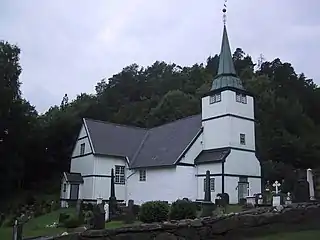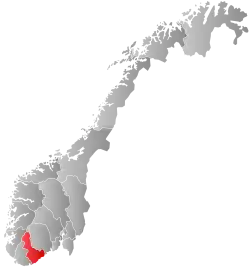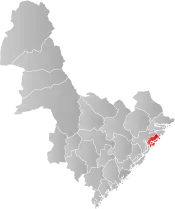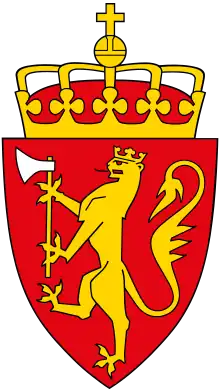Dypvåg
Dypvåg is a former municipality in the old Aust-Agder county, Norway. The 15-square-kilometre (5.8 sq mi) municipality existed from 1838 until its dissolution in 1960 when it was merged into the present-day municipality of Tvedestrand which is in Agder county. The small municipality included the coastal area about 8 kilometres (5.0 mi) east of the town of Tvedestrand and several islands located just offshore. The administrative centre was the village of Dypvåg where the Dypvåg Church is located.[1]
Dypvåg herred
Dybvaag herred (historic) | |
|---|---|
 View of the local church | |
 Aust-Agder within Norway | |
 Dypvåg within Aust-Agder | |
| Coordinates: 58°37′34″N 09°03′08″E | |
| Country | Norway |
| County | Aust-Agder |
| District | Østre Agder |
| Established | 1 Jan 1838 |
| • Created as | Formannskapsdistrikt |
| Disestablished | 1 Jan 1960 |
| • Succeeded by | Tvedestrand Municipality |
| Administrative centre | Dypvåg |
| Area (upon dissolution) | |
| • Total | 15 km2 (6 sq mi) |
| Population (1960) | |
| • Total | 1,805 |
| • Density | 120/km2 (310/sq mi) |
| Time zone | UTC+01:00 (CET) |
| • Summer (DST) | UTC+02:00 (CEST) |
| ISO 3166 code | NO-0915 |
History
The parish of Dybvaag (later spelled "Dypvåg") was established as a civil municipality on 1 January 1838 (see formannskapsdistrikt law). On 1 January 1881, a part of the municipality of Holt (population: 52) was transferred to Dypvåg. Then later, on 1 January 1887, an uninhabited part of neighboring Søndeled municipality was transferred to Dypvåg. On 1 January 1902, the western half of Dypvåg (population: 1,892) was separated from the rest of Dypvåg (population: 3,235) to form the new municipality of Flosta.[2]
During the 1960s, there were many municipal mergers across Norway due to the work of the Schei Committee. On 1 January 1960, the municipality of Dypvåg (population: 1,805) was merged with the neighboring municipality of Holt and the town of Tvedestrand to form a new, enlarged municipality of Tvedestrand which had a population of 6,432.[2]
Name
The municipality (originally the parish) is named after the old Dybvaag farm (Old Norse: Djúpvágr or Djúpivágr) since the first Dypvåg Church was built there. The first element comes from the word djúpr which means "deep". The last element is vágr which means "inlet" or "bay". Historically, the name was spelled Dybvaag, using a Danish spelling. Prior to the 1917 Norwegian language reform law, the name was spelled with the digraph "aa", and after this reform, the letter å was used instead. Also at this time, the b was changed to a p to give it a more Norwegian spelling.[3]
Government
While it existed, this municipality was responsible for primary education (through 10th grade), outpatient health services, senior citizen services, unemployment, social services, zoning, economic development, and municipal roads. During its existence, this municipality was governed by a municipal council of directly elected representatives. The mayor was indirectly elected by a vote of the municipal council.[4]
Mayors
The mayors (Norwegian: ordfører) of Dypvåg:
- 1838–1840: Schjøtt
- 1840–1841: Anders Larsen
- 1842–1853: Münster
- 1853–1855: G. Jensen
- 1855–1857: Ellev Knudsen
- 1858–1861: Ole Albretsen Tangvall
- 1862–1863: J.C. Christophersen
- 1863–1867: P.E. Olsen
- 1868–1873: Christian Olsen
- 1874–1877: Knud J. Nilsen
- 1878–1879: Ole Edv. Ellingsen
- 1880–1885: A.E. Olsen
- 1886–1898: J.M.A. Marcussen
- 1899–1904: K. Jensen
- 1905–1910: Haakon Thorvald Hansen (H)
- 1911–1925: Jens Marcussen (V)
- 1926–1928: M. Hareide
- 1928–1929: Yngve Sørensen
- 1930–1937: E.M. Christophersen
- 1938–1940: Halvor Halvorsen
- 1945-1945: Halvor Halvorsen
- 1946–1947: Gottfred Henriksen
- 1948–1959: P. Lande
Municipal council
The municipal council (Herredsstyre) of Dypvåg was made up of 21 representatives that were elected to four year terms. The tables below show the historical composition of the council by political party.
| Party Name (in Norwegian) | Number of representatives | |
|---|---|---|
| Labour Party (Arbeiderpartiet) | 6 | |
| Conservative Party (Høyre) | 7 | |
| Liberal Party (Venstre) | 8 | |
| Total number of members: | 21 | |
| Party Name (in Norwegian) | Number of representatives | |
|---|---|---|
| Labour Party (Arbeiderpartiet) | 5 | |
| Conservative Party (Høyre) | 6 | |
| Liberal Party (Venstre) | 9 | |
| Total number of members: | 20 | |
| Party Name (in Norwegian) | Number of representatives | |
|---|---|---|
| Labour Party (Arbeiderpartiet) | 5 | |
| Conservative Party (Høyre) | 7 | |
| Joint list of the Liberal Party (Venstre) and the Radical People's Party (Radikale Folkepartiet) | 8 | |
| Total number of members: | 20 | |
| Party Name (in Norwegian) | Number of representatives | |
|---|---|---|
| Labour Party (Arbeiderpartiet) | 6 | |
| Conservative Party (Høyre) | 7 | |
| Joint list of the Liberal Party (Venstre) and the Radical People's Party (Radikale Folkepartiet) | 7 | |
| Total number of members: | 20 | |
| Party Name (in Norwegian) | Number of representatives | |
|---|---|---|
| Labour Party (Arbeiderpartiet) | 2 | |
| Conservative Party (Høyre) | 9 | |
| Joint List(s) of Non-Socialist Parties (Borgerlige Felleslister) | 2 | |
| Local List(s) (Lokale lister) | 8 | |
| Total number of members: | 20 | |
| Note: Due to the German occupation of Norway during World War II, no elections were held for new municipal councils until after the war ended in 1945. | ||
Notable people
- Jens Marcussen (1926-2007), a politician
- Kristian Vilhelm Koren Schjelderup, Jr. (1894-1980), a theologian
- Peter Olrog Schjøtt (1833-1926), a philologist
References
- Thorsnæs, Geir, ed. (24 July 2015). "Dypvåg – tidligere kommune". Store norske leksikon (in Norwegian). Kunnskapsforlaget. Retrieved 1 January 2018.
- Jukvam, Dag (1999). "Historisk oversikt over endringer i kommune- og fylkesinndelingen" (PDF) (in Norwegian). Statistisk sentralbyrå. ISBN 9788253746845.
- Rygh, Oluf (1905). Norske gaardnavne: Nedenes amt (in Norwegian) (8 ed.). Kristiania, Norge: W. C. Fabritius & sønners bogtrikkeri. p. 36.
- Hansen, Tore; Vabo, Signy Irene, eds. (20 September 2022). "kommunestyre". Store norske leksikon (in Norwegian). Kunnskapsforlaget. Retrieved 1 January 2023.
- "Kommunevalgene og Ordførervalgene 1955" (PDF) (in Norwegian). Oslo: Statistisk sentralbyrå. 1957. Retrieved 20 December 2020.
- "Kommunevalgene og Ordførervalgene 1951" (PDF) (in Norwegian). Oslo: Statistisk sentralbyrå. 1952. Retrieved 20 December 2020.
- "Kommunevalgene og Ordførervalgene 1947" (PDF) (in Norwegian). Oslo: Statistisk sentralbyrå. 1948. Retrieved 20 December 2020.
- "Kommunevalgene og Ordførervalgene 1945" (PDF) (in Norwegian). Oslo: Statistisk sentralbyrå. 1947. Retrieved 20 December 2020.
- "Kommunevalgene og Ordførervalgene 1937" (PDF) (in Norwegian). Oslo: Statistisk sentralbyrå. 1938. Retrieved 20 December 2020.
External links
 Aust-Agder travel guide from Wikivoyage
Aust-Agder travel guide from Wikivoyage

